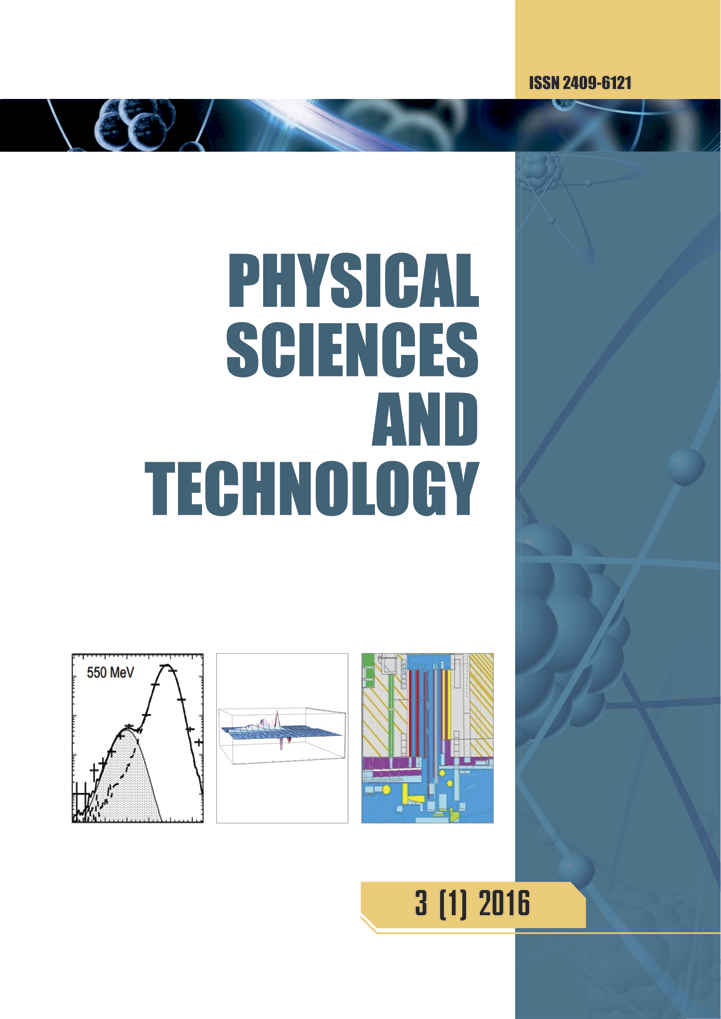FDTD modeling of the second harmonic generation in transition metamaterials
123 0
Keywords:
metamaterials, second harmonic generation, finite difference time domain, non-collinear interacting waves PACS numbers, 42.65.Ky, 42.65.Sf, 42.25.BsAbstract
On the basis of the classical Maxwell's equations the corresponding wave equations are derived for description of multiwave interactions in transition metamaterials whose refractive index varies along the sample from positive to negative values. The phenomenon of second harmonic generation is redicted in the transition layer near the point at which the refractive index turns zero, even at low intensities of the fundamental pumping wave. With the help of FDTD (finite difference time domain) mathematical modeling method it is found that the efficiency of the second harmonic generation in transition metamaterials strongly depends on the angle of incidence and the thickness of the transition layer. Specific recommendations are developed for the construction of a compact second harmonic generator based on transition metamaterials.References
[1] Litchinitser N.M., Maimistov A.I., Gabitov I.R., Sagdeev R.Z., and Shalaev V.M. Metamaterials: electromagnetic enhancement at zero-index transition // Opt. Lett. – 2008. – Vol. 33. – P. 2350-2352.
[2] Mozjerin I., Gibson E.A., Furlani E.P., Gabitov I.R., Litchinitser N.M. Electromagnetic enhancement in lossy optical transition metamaterials // Opt. Lett. – 2010. – Vol. 35. – P. 3240-3242.
[3] Alali F. and Litchinitser N.M. Gaussian Beams in Near-Zero Transition Metamaterials // Opt.Commun. – 2013. – Vol. 291. – P. 179-183.
[4] Zheludev N.I. and Kivshar Y.S. From metamaterials to metadevices // Nature Materials – 2012. – Vol. 11. – P. 917-924.
[5] Poutrina E., Huang D., and Smith D. R. Analysis of nonlinear electromagnetic metamaterials // N. J. Phys. – 2010. – Vol. 12. – P. 093010.
[6] Poutrina E., Huang D., Urzhumov Y., Smith D.R. Nonlinear oscillator metamaterial model: numerical and experimental verification // Opt. Express – 2011. – Vol. 19. – P. 8312-8319.
[7] Boyd R.W., Nonlinear optics. – 2nd ed. – San Diego: Academic Press, 2003. – 255 p.
[8] Franken P.A. and Ward J.F. Optical Harmonics and Nonlinear Phenomena // Rev. Mod. Phys. – 1963. – Vol. 35. – P. 23.
[9] Niesler F. B. P., Feth N., Linden S., and Wegener M. Second-harmonic optical spectroscopy on split-ringresonator arrays // Opt. Lett. – 2011. – Vol. 36. – P. 1533- 1535.
[10] Rose A.A., Huang D., and Smith D.R. Controlling the Second Harmonic in a Phase-Matched Negative- Index Metamaterial // Phys. Rev. Lett. – 2011. – Vol. 107. – P. 063902.
[11] KudyshevZh., Gabitov I., and Maimistov A. Effect of phase mismatch on second-harmonic generation in negative-index materials // Phys. Rev. A – 2013. – Vol. 87. – P. 063840.
[2] Mozjerin I., Gibson E.A., Furlani E.P., Gabitov I.R., Litchinitser N.M. Electromagnetic enhancement in lossy optical transition metamaterials // Opt. Lett. – 2010. – Vol. 35. – P. 3240-3242.
[3] Alali F. and Litchinitser N.M. Gaussian Beams in Near-Zero Transition Metamaterials // Opt.Commun. – 2013. – Vol. 291. – P. 179-183.
[4] Zheludev N.I. and Kivshar Y.S. From metamaterials to metadevices // Nature Materials – 2012. – Vol. 11. – P. 917-924.
[5] Poutrina E., Huang D., and Smith D. R. Analysis of nonlinear electromagnetic metamaterials // N. J. Phys. – 2010. – Vol. 12. – P. 093010.
[6] Poutrina E., Huang D., Urzhumov Y., Smith D.R. Nonlinear oscillator metamaterial model: numerical and experimental verification // Opt. Express – 2011. – Vol. 19. – P. 8312-8319.
[7] Boyd R.W., Nonlinear optics. – 2nd ed. – San Diego: Academic Press, 2003. – 255 p.
[8] Franken P.A. and Ward J.F. Optical Harmonics and Nonlinear Phenomena // Rev. Mod. Phys. – 1963. – Vol. 35. – P. 23.
[9] Niesler F. B. P., Feth N., Linden S., and Wegener M. Second-harmonic optical spectroscopy on split-ringresonator arrays // Opt. Lett. – 2011. – Vol. 36. – P. 1533- 1535.
[10] Rose A.A., Huang D., and Smith D.R. Controlling the Second Harmonic in a Phase-Matched Negative- Index Metamaterial // Phys. Rev. Lett. – 2011. – Vol. 107. – P. 063902.
[11] KudyshevZh., Gabitov I., and Maimistov A. Effect of phase mismatch on second-harmonic generation in negative-index materials // Phys. Rev. A – 2013. – Vol. 87. – P. 063840.
Downloads
How to Cite
Kudyshev, Z. A., Davletov, A. E., Gabitov, I. R., Kisan, A., & Mukhametkarimov, Y. S. (2015). FDTD modeling of the second harmonic generation in transition metamaterials. Physical Sciences and Technology, 1(2). Retrieved from https://phst.kaznu.kz/index.php/journal/article/view/48
Issue
Section
Plasma Physics and Related Technology




